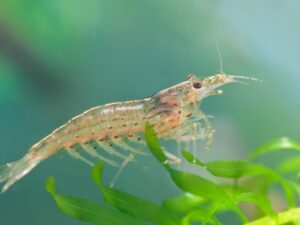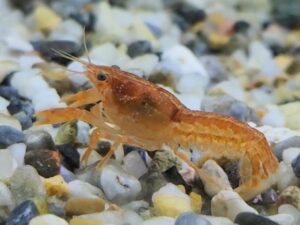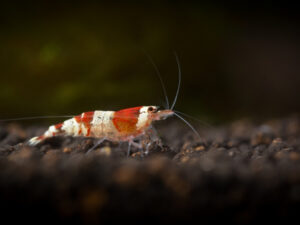Cherry shrimp are a type of freshwater shrimp found in the Taiwan. They are a popular choice for aquariums because they are small, colorful, and easy to care for.
Also, they love to eat algae, making them a great addition to any tank.
This guide will discuss everything you need to know about cherry shrimp, including their habitat, diet, and care requirements.
Table of Contents
- Species Summary
- Cherry Shrimp Care
- Tank Size For Cherry Shrimp
- Water parameters For Cherry Shrimp
- Filtration
- Heating
- Lighting
- Co2 Systems
- Substrate For Cherry Shrimp
- Plants
- Decorations
- Other Tank Accessories
- Water Changes
- Cleaning The Tank
- Cleaning The Filter
- Testing The Water
- Cherry Shrimp Common Possible Diseases
- Symptoms Of Diseases In Cherry Shrimp
- Preventing Diseases
- Cherry Shrimp Treatment And Medications Of Diseases
- Cherry Shrimp Food & Diet
- Cherry Shrimp Diet Foods To Avoid
- Cherry Shrimp Feeding Schedule
- Cherry Shrimp shedding process
- Cherry Shrimp Tank Mates
- Fish To Avoid
- Advantages Of Having Cherry Shrimp In Your Tank
- Disadvantages Of Having Cherry Shrimp In Your Tank
- Conclusion
Species Summary
| Scientific name: | Neocaridina heteropoda |
| Common name: | Cherry shrimp |
| Family: | Atyidae |
| Origin: | Taiwan |
| Size: | Up to 1.5 inches |
| Life span: | 1-3 years |
| Habitat: | Freshwater |
| Behavior: | Peaceful |
| Tank size: | Minimum 2 gallons |
| Temperature range: | 65°-85°F |
| ph Range: | 6.5-8.0 |
| Water hardness: | Soft |
| Water type: | Fresh |
| Activity Level: | Moderate |
| Compatibility: | Excellent |
| Tankmates: | Many, but be mindful of their size |
| Care requirements: | Easy to care for; can tolerate a range of water conditions |
| Breeding: | Easy |
| Diet: | Algae and other small invertebrates |
Cherry shrimp, also known as Red Cherry shrimp (RCS), is a freshwater shrimp found in the Taiwan. Their scientific name is Neocaridina heteropoda, and they are in the Atyidae family. They are easy to care for shrimp that can tolerate various water conditions.
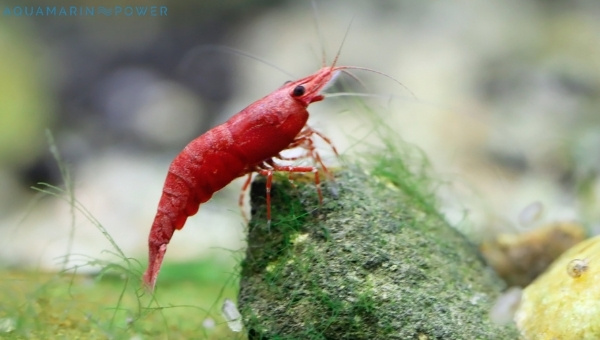
They are also “graded” by their color, which we will discuss more in-depth later. The most popular color is the red, but they also come in blue, yellow, and green.
Cherry Shrimp Appearance
Cherry shrimp get their name from their characteristic red color. They can also come in other colors, including blue, yellow, and green.
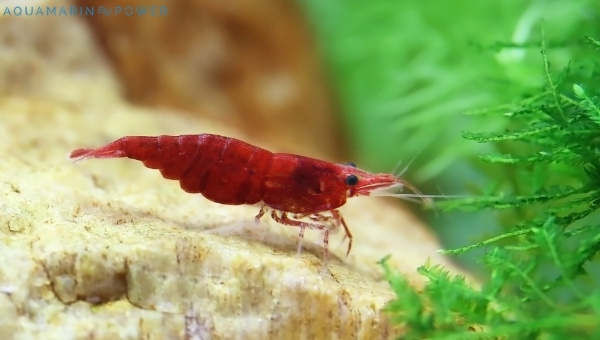
They have a “round” shape and are covered in a softshell. They have two pairs of antennae, and their eyes are on stalks. It is hard to differentiate between the male and female shrimp until they are adults. Once matured, the females will be larger and have a more “rounded” shape than the males. The presence of an orange “saddle” area under the tail is a good indicator that the shrimp is a male.
Due to selective breeding, there are now many different color morphs of cherry shrimp available.
They are typically a dark green or brown color in the wild, but they can change color to match their surroundings.
Cherry Shrimp Size & Growth Rate
The cherry shrimp can range anywhere from 1/2 inch to1.5 inches. The average size is around 1 inch. Cherry shrimp grow at a moderate pace, and they will reach their full size in about 1-2 years.
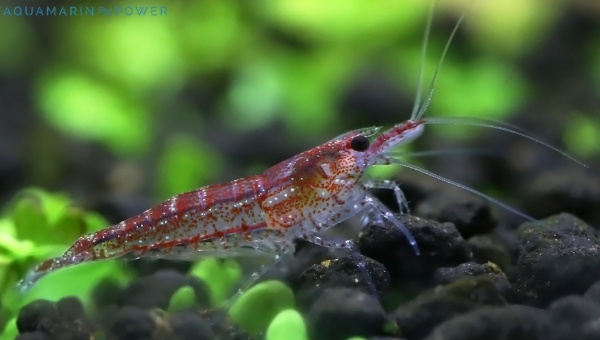
The females tend to be a little bit larger than the males. As they grow, they will also get more colorful.
Cherry Shrimp Lifespan
The average lifespan of a is around 1-2 years. With the proper care, they can live up to 3 years.
They make an excellent choice for both new and experienced aquarists with high breeding potential and easy care requirements.
Cherry Shrimp Behavior & Temperament
In nature, cherry shrimp are a peaceful species and get along well with other fish and invertebrates. In the home aquarium, they will typically stay near the bottom of the tank and will not bother other fish or shrimp.
However, there is always the potential for aggression, especially when food is involved. If you have a larger tank, you may be able to keep more than one colony of shrimp. However, if you have a smaller tank, it is best to keep only one colony to avoid any potential aggression.
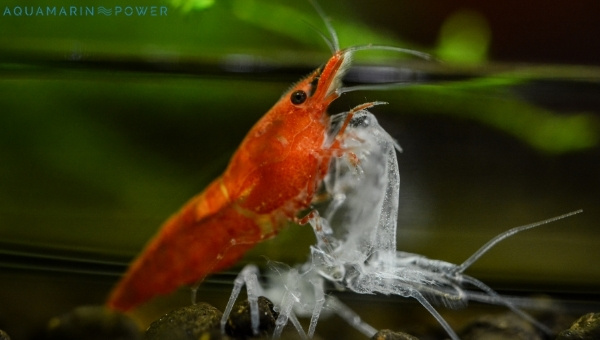
They make an excellent addition to the home aquarium and are a great way to help keep the tank clean. By providing them with a healthy diet and a peaceful environment, you can help ensure that they thrive and live long healthy lives.
When they feel secure, they open up a flap to their shell called the operculum. This is used as a means of communication and can be seen when feeding, mating, or being defensive.
Cherry Shrimp Breeding
Cherry shrimp are a popular choice for breeding in the home aquarium. To breed them, you will need to provide them with a healthy diet and a peaceful environment.
When they are ready to breed, the male and female will form a mating pair. The male will then transfer sperm to the female using his tail. The female will then store the sperm until she is ready to lay eggs.
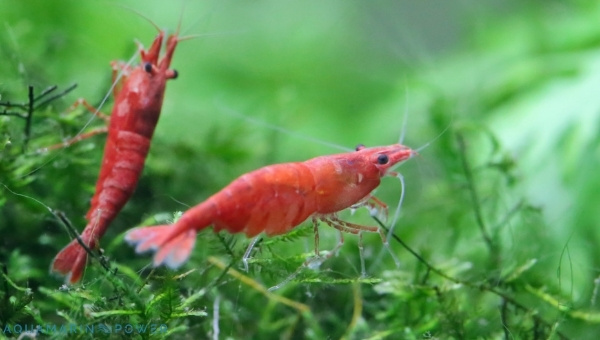
The eggs will be laid on a surface where they can be fertilized and will hatch in about two weeks. The baby shrimp will then be able to swim on their own.
Another method of breeding them is to use an egg incubator. This is a container filled with water with a heater and air pump. The eggs will be placed in the incubator and hatch in about two weeks.
By providing a healthy diet and a peaceful environment, you can help increase the chances of your shrimp breeding successfully.
Cherry Shrimp Color Grading
To gauge the quality and help with the selective breeding process, shrimp farmers and enthusiasts have developed a color grading system for cherry shrimp.
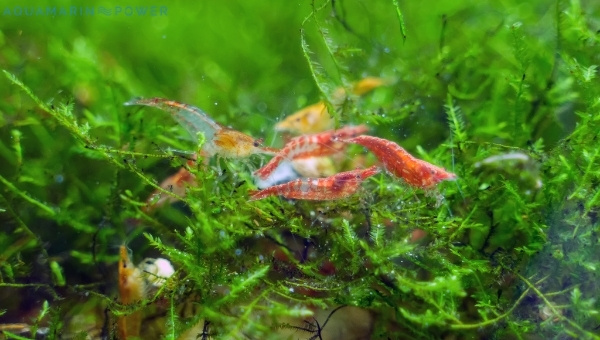
The grading goes as follows:
- High Grade: Painted Fire Red Cherry Shrimp: This is the highest grade and refers to completely red shrimp. They will also have a high level of color intensity.
- Medium-High Grade: Fire Red Cherry Shrimp: These are primarily red but may have some green or black markings.
- Medium Grade: Sakura Cherry Shrimp: These are primarily red but may have some white markings.
- Low Grade: Basic Cherry Shrimp: These shrimp are a mix of colors and will not be as brightly colored as the higher grade shrimp.
The price of these shrimp goes up with the grade, with the highest grade shrimp being the most expensive.
Cherry Shrimp Care
Cherry shrimp care is relatively easy, and they can tolerate a range of water conditions. These animals are very low maintenance and make an excellent choice for new and experienced aquarists.
They can be kept in various water conditions, but it is best to keep them in a tank with soft water. They do well in tanks with live plants, and they will eat the algae.
This section will go over the primary care requirements.
Tank Size For Cherry Shrimp
The minimum tank size for keeping cherry shrimp is 2 gallons. However, the more shrimp you have, the larger the tank should be. A good rule of thumb is to have 10 gallons per 1 inch of shrimp. So, if you have 1 inch of shrimp, your tank should be at least 10 gallons.
They produce small amounts of waste, which is not difficult to manage in a small tank. So if you are keeping more than ten shrimp, you will need to upgrade to a larger tank.
When setting up your tank, include plenty of hiding places for the shrimp. This can be done by using rocks, driftwood, and live plants.
Water parameters For Cherry Shrimp
Cherry shrimp are flexible and can tolerate a range of water conditions. However, it is best to keep them in a tank with soft water. The ideal pH range for cherry shrimp is 6.5-8.0. The temperature should be kept between 65°-85°F.
The water hardness should be between 4-18 dGH, and the water should be filtered and changed regularly.
However, it is essential to note that cherry shrimp are not a “hardy” species, and they can be sensitive to changes in water conditions. So, if you are not experienced with keeping fish, it is best to keep the water parameters within the recommended range.
Filtration
When setting up your tank, it is essential to include a good quality filter. This is especially important if you keep live plants in the tank, as the plants will produce waste that can pollute the water.
A good quality filter will help to keep the water clean and healthy for your shrimp. When using filtration systems, precautions should be taken because they are a dwarf species; they are sucked easily into the filter.
There are many different filters available on the market, so be sure to do your research and find one that fits your needs.
Some recommended filters for cherry shrimp tanks include:
- Aqua Clear 70 Power Filter: These filters are quiet and efficient, and they come with a variety of filtration media
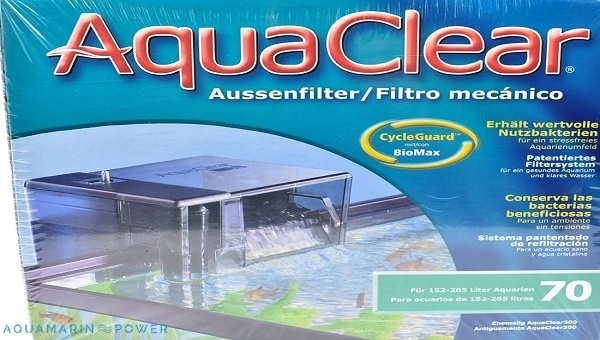
- Aqueon Quiet Flow Pro Series Filters: These filters are very quiet and have a large filter media capacity
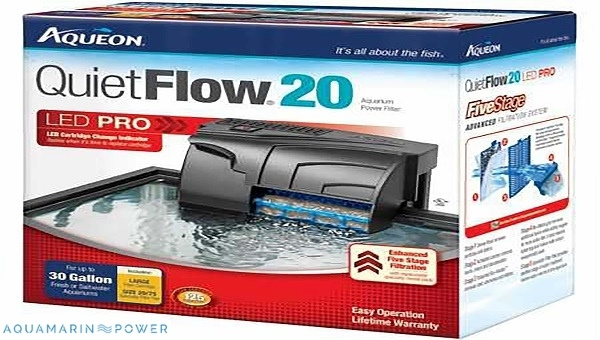
Heating
The ideal temperature range for cherry shrimp is 65°-85°F. If the temperature falls outside of this range, the shrimp may become stressed and may not survive.
Therefore, it is essential to include a heater in your tank if it falls below 65°. There are several different heaters available on the market, so be sure to find one that fits your needs.
Some recommended heaters for cherry shrimp tanks include:
- Eheim Jager Heaters: These heaters are reliable and accurate, and they come in a variety of sizes.
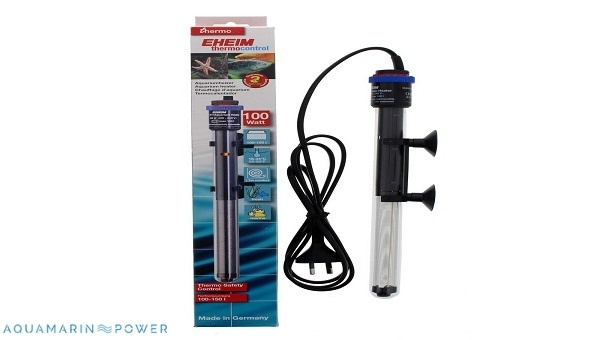
- Aquatop Heaters: These heaters are affordable and come in a variety of sizes.
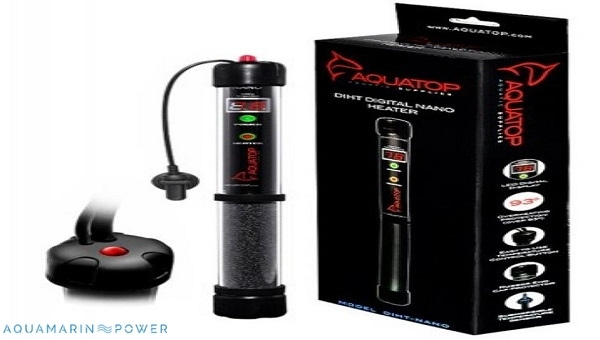
- Hydor Theo Heaters: These heaters are stylish and come in a variety of sizes.
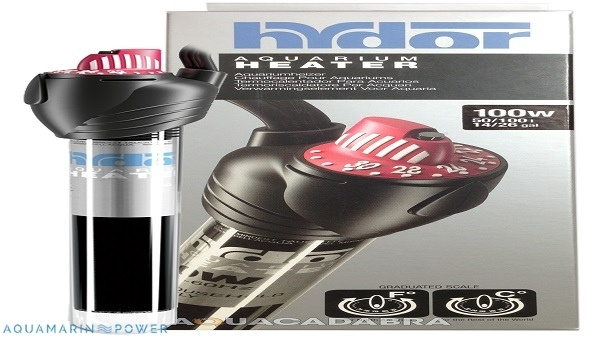
Lighting
Cherry Shrimp do not require a lot of light, and they can tolerate low light levels. However, it is still important to include lighting in your tank. This can be done using a regular fluorescent light or an LED light.
If you are using a regular fluorescent light, be sure to purchase one that has a low Kelvin rating. Some recommended lights for cherry shrimp tanks include:
- Aqueon LED strip lights: These lights are affordable and come in various sizes.
- Current USA Satellite Freshwater LED Plus Light: This light is very bright and covers a large area.
- Zoo Med Aquatic Plant & Reptile Illuminator: This light is perfect for planted tanks, and it comes in a variety of sizes
Co2 Systems
Cherry shrimp do not require a Co2 system, but it can be beneficial to have one. A Co2 system will help increase the plants’ growth rate in your tank, and it will also help keep the water quality high.
There are several different Co2 systems available on the market, so be sure to find one that fits your needs.
Some recommended Co2 systems for cherry shrimp tanks include:
- Fluval Pressurized CO2 System: This system is easy to use and comes with a regulator and solenoid.
- Aqua Medic CO2 System: This system is durable and comes with a pressure gauge.
- Hagen Elite CO2 System: This system is easy to use and comes with a bubble counter.
Substrate For Cherry Shrimp
A substrate will help to keep the water clean and healthy, and it will also provide a place for the shrimp to hide.
There are some different substrates available on the market, so be sure to find one that fits your needs.
Some recommended substrates for cherry shrimp tanks include:
- Aqua Soil: This substrate is affordable and comes in a variety of sizes.
- Planted aquarium sands: These sands are inexpensive and come in a variety of colors.
- Coralife Plant Substrate: This substrate is perfect for planted tanks, and it comes in a variety of sizes.
Plants
Cherry shrimp love to live in planted tanks, and they will thrive in an environment with plenty of plants.
There are a number of different plants available on the market, so be sure to find one that fits your needs.
Some recommended plants for cherry shrimp tanks include:
- Anacharis: This plant is easy to grow and does not require a lot of light.
- Java moss: This plant is easy to grow and does not require a lot of light.
- Frogbit: This plant is easy to grow and does not require a lot of light.
- Water wisteria: This plant is fast-growing and can reach up to 18 inches in height.
Decorations
Cherry shrimp love to live in an environment with plenty of decorations, and they will thrive in an environment with many places to hide.
There are a number of different decorations available on the market, so be sure to find one that fits your needs.
Some recommended decorations for Cherry Shrimp tanks include:
- Malaysian driftwood: This wood is affordable and comes in a variety of shapes and sizes.
- Silk plants: These plants are affordable and come in a variety of colors.
- Resin decorations: These decorations are affordable and come in a variety of shapes and sizes.
Other Tank Accessories
There are a few other things you may want to consider when setting up your cherry shrimp tank.
Some other tank accessories that can be beneficial for cherry shrimp tanks include:
- Aquarium chiller: If your tank is located in a warm area, you may want to consider using a chiller to keep the water cool.
- Aquarium thermometer: This thermometer will help you to monitor the temperature of the water.
- ph Meter: This meter will help you to monitor the pH level of the water.
- Water conditioner: This conditioner will help to keep the water healthy and free of harmful chemicals.
You can set up the perfect Cherry Shrimp tank for your fish by following these tips.
Water Changes
It is essential to perform water changes regularly to keep the water clean and healthy.
How often you should perform water changes depends on many factors, including the size of your tank, the type of substrate you are using, and the number of plants you have in your tank.
When changing the water, you should:
- Remove all of the water from the tank.
- Clean the tank with a fish-safe cleaner.
- Refill the tank with fresh, dechlorinated water.
- Replace any decorations or plants you removed from the tank.
By following these tips, you can keep your cherry shrimp tank healthy and free of harmful chemicals.
Consult with an experienced aquarist to determine how often you should perform water changes in your tank.
Cleaning The Tank
Cleaning the tank is essential for keeping the water clean and healthy.
When cleaning the tank, you should:
- Remove all of the decorations from the tank.
- Scrub the sides of the tank with a clean brush.
- Rinse the gravel with clean water.
- Refill the tank with clean, treated water.
- Add a dechlorinator to the new water.
After you have finished cleaning the tank, you should check the water parameters to ensure they are within the recommended ranges.
Cleaning The Filter
Cleaning the filter is important for keeping the water clean and healthy.
When cleaning the filter, you should:
- Remove all of the media from the filter.
- Rinse the media with clean water.
- Refill the media chamber with fresh, dechlorinated water.
- Replace the media in the filter.
Some recommended filter media for Cherry Shrimp tanks include:
- Activated carbon: This carbon will help to remove harmful chemicals from the water
- Zeolite: This zeolite will help to remove ammonia and nitrite from the water
Testing The Water
It is important to test the water in your tank regularly to ensure that it is healthy and free of harmful chemicals.
The most common water parameters you should test for include:
- Ammonia: You can use an ammonia test kit to test for ammonia levels.
- Nitrite: You can use a nitrite test kit to test for nitrite levels.
- pH: You can use a pH meter to test the pH level of the water.
- Temperature: You can use an aquarium thermometer to monitor the temperature of the water.
By testing the water in your tank, you can take corrective actions to ensure that the water is healthy and free of harmful chemicals.
Cherry Shrimp Common Possible Diseases
There are many common diseases that can affect cherry shrimp.
Some of the most common diseases include:
- Bacterial infections: These infections can cause the shrimp to lose their color and become lethargic.
- Fungal infections: These infections can cause the shrimp to develop lesions on their body.
- Parasitic infections: These infections can cause the shrimp to lose weight and become lethargic.
By knowing the signs and symptoms of these common diseases, you can take corrective actions to help your shrimp recover.
Consult with an experienced Veterinarian/aquarist for more information on common conditions that can affect your shrimp.
Symptoms Of Diseases In Cherry Shrimp
The symptoms of common diseases can vary depending on the disease.
However, some common symptoms of diseases include:
- Loss of color
- Lethargy
- Rapid breathing
- Inactivity
- Reduced appetite
- Mucus on the body
- Lesions on the body
By knowing the signs and symptoms of common diseases, you can take the appropriate actions to help your shrimp recover.
Preventing Diseases
There are a number of things you can do to help prevent common diseases from affecting your cherry shrimp.
Some of the most effective methods include:
- Quarantining new shrimp before adding them to your tank.
- Regularly cleaning the tank and filter.
- Testing the water parameters regularly.
You can help keep your tank healthy and free of harmful diseases by following these tips.
Cherry Shrimp Treatment And Medications Of Diseases
If you notice that your shrimp are showing signs of a disease, it is essential to take corrective actions as soon as possible.
Some common treatments and medications for diseases include:
- Bacterial infections: Antibiotics can be used to treat bacterial infections.
- Fungal infections: Antifungal medications can be used to treat fungal infections.
- Parasitic infections: Medications can be used to treat parasitic infections.
By consulting with an experienced aquarist, you can find the best treatment and medications for the diseases affecting your shrimp.
Cherry Shrimp Food & Diet
In nature, Cherry shrimp are omnivorous and eat a variety of things, including algae, zooplankton, and detritus.
In the home aquarium, you can feed them a variety of things, including:
- Algae wafers: These wafers are a great source of nutrition for shrimp.
- Zooplankton: This can be either live or freeze-dried.
- Crustacean diet: This diet is specifically designed for shrimp and contains various nutrients. Some examples include New Life Spectrum H2O Stable, Hikari Crab Cuisine, and Wardley Shrimp Pellets.
- Sinking shrimp pellets: These pellets sink to the bottom of the tank and are a great source of nutrition for shrimp.
- Freeze-dried bloodworms: These worms are a great source of protein and can be fed once or twice a week.
For snacks, you can also feed your shrimp some of the following:
- Frozen peas
- Frozen brine shrimp
- Frozen bloodworms
Some vegetables such as cucumber, spinach, zucchini, lettuce, and carrots are also safe to feed to shrimp. By providing a variety of food items, you can ensure that your shrimp will get the nutrients they need to stay healthy.
Cherry Shrimp Diet Foods To Avoid
While there are some safe food items to feed your cherry shrimp, there are also some foods you should avoid.
Some of these foods include:
- Raw meat: This can contain harmful bacteria that can cause diseases in shrimp.
- Uncooked grains: These can contain mold and other toxins that can be harmful to shrimp.
- Fruit: This can contain sugar which can lead to health problems in shrimp.
- Sugar: This can also lead to health problems in shrimp.
These foods should not be fed to your shrimp as they can cause health problems. Avoiding these foods can help keep your shrimp healthy and free of diseases.
Cherry Shrimp Feeding Schedule
How often you should feed your Cherry Shrimp will depend on various factors, including the type of food you are providing, the size of your tank, and the number of shrimp in the tank.
Generally, you should feed your shrimp once or twice a day. However, read the instructions on the food items you are providing to make sure they are not overfed.
Overfeeding can lead to many problems, including:
- Excess waste in the tank
- Pollution of the water
- Algae growth
By following a feeding schedule and providing only the amount of food your shrimp need, you can help keep your tank healthy and free of unwanted debris.
Cherry Shrimp shedding process
The molting process, or shedding process, is when the exoskeleton of the shrimp is shed, and a new one is grown. This typically occurs every 1-2 months and can be seen as a new shell growing under the old one.
During molting, the shrimp will become very weak and will not be able to swim or feed properly. It is important to provide them with a quiet, dark place to molt to avoid predators.
After the new shell has grown in, the shrimp will be able to swim and normally feed again. However, they will be very vulnerable until the new exoskeleton has hardened and should not be disturbed.
Cherry Shrimp Tank Mates
Cherry shrimp can be kept with a variety of other fish and invertebrates.
Some good tank mates include:
- Different types of shrimp: They can get along with the following shrimp.
- Amano shrimp: These shrimp are great for algae control and can be kept with any kind of shrimp.
- Ghost shrimp: These are an excellent option for beginners as they are hardy and peaceful.
- Vampire Shrimp: These shrimp are great for scavenging and can be kept with any type of shrimp.
Some fishes that can be kept with cherry shrimp include:
- Bristlenose plecos: These plecos are great for algae control.
- Neon tetras: These tetras are a popular choice for beginners and are peaceful fish.
- Barbs: There are a number of different barbs that can be kept with shrimp, including the tiger barb and gold barb.
- Siamese Algae eaters: These algae eaters are great for keeping the tank clean.
- Danios: These fish are hardy and can withstand a wide range of water conditions.
- Oscars: Oscars can be aggressive but typically do well with shrimp.
- Guppies: Guppies are a hardy fish that can tolerate a wide range of water conditions.
- Cory cats: These cats are great for cleaning up the bottom of the tank.
- Mollies: Mollies are another hardy fish that can tolerate a wide range of water conditions.
- Platys: Platys are a hardy fish that can tolerate a wide range of water conditions.
By choosing a variety of fish and invertebrates compatible with them, you can help create a healthy and harmonious tank environment.
Fish To Avoid
Cherry shrimp tend to get along well with most other fish and invertebrates. However, there are a few species that you should avoid keeping with.
Some of these include:
- Fish that eat shrimp: Some fish, such as pufferfish, are known to eat shrimp. If you have any of these fish in your tank, it is best not to keep Cherry Shrimp.
- Other invertebrates: Some invertebrates, such as hermit crabs, may eat them. If you have any of these in your tank, it is best not to keep Cherry Shrimp.
By avoiding these species, you can help reduce the risk of your shrimp being eaten.
Advantages Of Having Cherry Shrimp In Your Tank
By having cherry shrimp in your tank, you can enjoy various benefits.
- The first advantage of having Cherry Shrimp in your tank is that they are an excellent food source for other fish. They are also a great source of protein.
- The second advantage is that they help to keep the tank clean. They scavenge for food and algae, helping to reduce the amount of waste in the tank.
- The third advantage is that they can be used to breed other shrimp. By providing a healthy diet and a peaceful environment, you can increase the chances of them breeding successfully.
- The fourth advantage is that they are an excellent option for beginners. They are hardy and peaceful, making them a good choice for those just starting in the hobby.
- The fifth advantage is that they come in various colors, making them a popular choice for those looking to add some color to their tank.
- The sixth advantage is that they can be used to help control the population of snails in your tank. Snails can be a nuisance and can damage plants and decorations. Cherry shrimp can help to control their population.
- The last advantage is that they can be used to help control the population of algae in your tank. Algae can be a nuisance and can clog up the filters. Cherry shrimp can help to control their population.
Disadvantages Of Having Cherry Shrimp In Your Tank
- The first disadvantage of having cherry shrimp in your tank is that they can scavenge for food and algae, reducing the amount of waste in the tank. This can lead to an increase in ammonia and nitrite levels in the tank.
- Another disadvantage is that they can be a source of food for other fish. If you have fish that eat shrimp, they may eat your cherry shrimp.
Conclusion
As you can see, there are various benefits to having cherry shrimp in your tank. They are a great source of food for other fish, they help to keep the tank clean, and they can be used to breed other shrimp. By providing a healthy diet and a peaceful environment, you can increase the chances of them breeding successfully.
However, few disadvantage of having cherry shrimp in your tank is that they can scavenge for food and algae, reducing the amount of waste in the tank. This can lead to an increase in ammonia and nitrite levels in the tank. So, before you decide to add cherry shrimp to your tank, make sure you weigh the pros and cons.
Thank you for reading! I hope this article has helped you.

